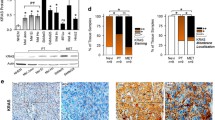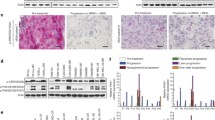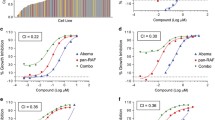Abstract
The clinical benefit of selective BRAF inhibitor therapies is limited by the emergence of drug resistance. Here, we investigated the molecular basis underlying the acquired resistance to a BRAF inhibitor by comparing the signaling pathways in the parental A375P cells and the resistant subline (A375P/Mdr). We demonstrate that MAPK re-activation does not contribute to the mechanism of resistance to UAI-201 of A375P/Mdr cells. The relative quantitative analysis using the 2−ΔΔCt method revealed that the BRAF inhibitor resistance observed in A375P/Mdr cells is not mediated through the overexpression of MDR proteins. In particular, we found that the expression of N-Ras was upregulated in BRAF inhibitor-resistant A375P/Mdr cells compared with A375P cells. In fact, siRNA-mediated N-Ras knockdown partially conferred UAI-201 sensitivity to A375P/Mdr cells, implying that N-Ras upregulation confers acquired resistance to BRAF inhibition. Notably, the flow cytometric analysis of the N-Ras-knockdown A375P/Mdr cells revealed that UAI-201 causes a significant accumulation of cells in the G 0/G 1 phase with a concomitant decrease in the number of cells in the S and G 2/M phases. However, platelet-derived growth factor receptor β (PDGFRβ) knockdown failed to sensitize A375P/Mdr cells to growth suppression by UAI-201, although a remarkable increase in PDGFRβ was observed in the A375P cells after UAI-201 treatment. Taken together, our results suggest that N-Ras is worth targeting to improve the therapeutic outcome of melanomas with acquired resistance to BRAF inhibitors.





Similar content being viewed by others
References
Davies H, Bignell G, Cox C, Stephens P, Edkins S, Clegg S, Teague J, Woffendin H, Garnett MJ, Bottomley W et al (2002) Mutations of the B-Raf gene in human cancer. Nature 417:949–954
Karasarides M, Chiloeches A, Hayward R, Niculescu-Duvaz D, Scanlon I, Friedlos F, Ogilvie L, Hedley D, Martin J, Marshall CJ et al (2004) B-RAF is a therapeutic target in melanoma. Oncogene 23:6292–6298
Wilhelm SM, Carter C, Tang L, Wilkie D, McNabola A, Rong H, Chen C, Zhang X, Vincent P, McHugh M et al (2004) BAY 43-9006 exhibits broad spectrum oral antitumor activity and targets the RAF/MEK/ERK pathway and receptor tyrosine kinases involved in tumor progression and angiogenesis. Cancer Res 64:7099–7109
Tsai J, Lee JT, Wang W, Zhang J, Cho H, Mamo S, Bremer R, Gillette S, Kong J, Haass NK et al (2008) Discovery of a selective inhibitor of oncogenic B-Raf kinase with potent antimelanoma activity. Proc Natl Acad Sci USA 105:3041–3046
Ahn J-H, Ahn SK, Lee M (2012) The role of autophagy in cytotoxicity induced by new oncogenic B-Raf inhibitor UI-152 in v-Ha-ras transformed fibroblasts. Biochem Biophys Res Commun 417:857–863
Kim Y-K, Ahn SK, Lee M (2012) Differential sensitivity of melanoma cell lines with differing B-Raf mutational status to the new oncogenic B-Raf kinase inhibitor UI-152. Cancer Lett 320:215–224
Engelman JA, Jänne PA (2008) Mechanisms of acquired resistance to epidermal growth factor receptor tyrosine kinase inhibitors in non-small cell lung cancer. Clin Cancer Res 14:2895–2899
Pao W, Miller VA, Politi KA, Riely GJ, Somwar R, Zakowski MF, Kris MG, Varmus H (2005) Acquired resistance of lung adenocarcinomas to gefitinib or erlotinib is associated with a second mutation in the EGFR kinase domain. PLoS Med 2:e73
Flaherty KT, Puzanov I, Kim KB, Ribas A, McArthur GA, Sosman JA, O’Dwyer PJ, Lee RJ, Grippo JF, Nolop K et al (2010) Inhibition of mutated, activated BRAF in metastatic melanoma. N Engl J Med 363:819–908
Callaghan R, Higgins CF (1995) Interaction of tamoxifen with the multidrug resistance P-glycoprotein. Br J Cancer 71:294–299
Gottesman MM (2002) Mechanisms of cancer drug resistance. Annu Rev Med 53:615–627
Wu CP, Calcagno AM, Ambudkar SV (2008) Reversal of ABC drug transporter-mediated multidrug resistance in cancer cells: evaluation of current strategies. Curr Mol Pharmacol 1:93–105
Goldstein LJ, Galski H, Fojo A, Willingham M, Lai SL, Gazdar A, Pirker R, Green A, Crist W, Brodeur GM et al (1989) Expression of a multidrug resistance gene in human cancers. J Natl Cancer Inst 81:116–124
Ahn J-H, Lee M (2013) Autophagy-dependent survival of mutant B-Raf melanoma cells selected for resistance to apoptosis induced by inhibitors against oncogenic B-Raf. Biomol Ther 21:114–120
Johannessen CM, Boehm JS, Kim SY, Thomas SR, Wardwell L, Johnson LA, Emery CM, Stransky N, Cogdill AP, Barretina J et al (2010) COT drives resistance to RAF inhibition through MAP kinase pathway reactivation. Nature 468:968–972
Nazarian R, Shi H, Wang Q, Kong X, Koya RC, Lee H, Chen Z, Lee MK, Attar N, Sazegar H et al (2010) Melanomas acquire resistance to B-RAF(V600E) inhibition by RTK or N-RAS upregulation. Nature 468:973–977
Livak KJ, Schmittgen TD (2001) Analysis of relative gene expression data using real-time quantitative PCR and the 2−DDCt Method. Methods 25:402–408
Montero-Conde C, Ruiz-Llorente S, Dominguez JM, Knauf JA, Viale A, Sherman EJ, Ryder M, Ghossein RA, Rosen N, Fagin JA (2013) Relief of feedback inhibition of HER3 transcription by RAF and MEK inhibitors attenuates their antitumor effects in BRAF-mutant thyroid carcinomas. Cancer Discov 3:520–533
Little AS, Balmanno K, Sale MJ, Newman S, Dry JR, Hampson M, Edwards PA, Smith PD, Cook SJ (2011) Amplification of the driving oncogene, KRAS or BRAF, underpins acquired resistance to MEK1/2 inhibitors in colorectal cancer cells. Sci Signal 4:17–21
Wilson TR, Fridlyand J, Yan Y, Penuel E, Burton L, Chan E, Peng J, Lin E, Wang Y, Sosman J et al (2012) Widespread potential for growth-factor-driven resistance to anticancer kinase inhibitors. Nature 487:505–509
Acknowledgments
This research was supported by Basic Science Research Program through the National Research Foundation of Korea (NRF) funded by the Ministry of Education, Science and Technology (2013R1A1A2A10058897).
Author information
Authors and Affiliations
Corresponding author
Rights and permissions
About this article
Cite this article
Ahn, JH., Lee, M. The siRNA-mediated downregulation of N-Ras sensitizes human melanoma cells to apoptosis induced by selective BRAF inhibitors. Mol Cell Biochem 392, 239–247 (2014). https://doi.org/10.1007/s11010-014-2034-2
Received:
Accepted:
Published:
Issue Date:
DOI: https://doi.org/10.1007/s11010-014-2034-2




